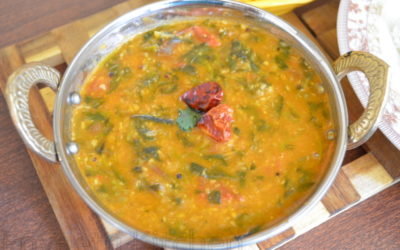Just as Poha is synonymous to Maharashtra and Gujarat, Pongal is synonymous with the states of Tamil Nadu, Karnataka and Andhra Pradesh, although the Bhagasastra provides us with recipes from other regions of the country as well. Pongal is called pongali in Andhra Pradesh and huggi in Karnataka. In Tamil “pongal” means “bubbling up”. In Telugu and Kannada Pongali is a dish of rice mixed with boiled milk and sugar.
Huggi is derived from Old Kannada word Puggi meaning “bubbled up, ballooning”. The two varieties of Pongal are chakarai Pongal which is sweet, and venn Pongal, which is made from clarified butter. The word Pongal generally refers to spicy pongal and is a common breakfast food. The rice boiled with milk and jaggery during the Pongal festival is called chakarai Pongal, made specially in earthenware pots with a wood fire.
Pongal, the dish named after a Festival .
The dish Pongal is made from the first harvest of rice and coincides with the Tamil New year of Pongal which falls in the middle of January each year. The festival is also referred to as Thai pongal and is a multi-day Hindu harvest festival of South India. It is observed at the start of the month Tai according to the Tamil solar calendar and is dedicated to the sun god Surya, and corresponds to Makar Sankranti, the harvest festival under many regional names celebrated throughout India. The three days of the Pongal festival are called Bhogi Pongal, Surya Pongal and Maattu Pongal.
According to tradition, the festival marks the end of winter solstice, and the start of the sun’s six- month-long journey northwards (the Uttaraayanam) when the sun enters the zodiac Makara (Capricorn). The festival is named after the ceremonial “Pongal”, which means “to boil, overflow” and refers to the traditional dish prepared from the new harvest of rice boiled in milk with jaggery (raw sugar). To mark the festival, the pongal sweet dish is prepared, first offered to the gods and goddesses (goddess Pongal), followed sometimes with an offering to cows, and then shared by the family. Festive celebrations include decorating cows and their horns, ritual bathing and processions. It is traditionally an occasion for decorating rice-powder based kolam artworks, offering prayers in the home, temples, getting together with family and friends, and exchanging gifts to renew social bonds of solidarity.
Pongal is one of the most important festivals celebrated by Tamil people in Tamil Nadu and Puducherry in India, Sri Lanka and the Tamil diaspora worldwide, including those in Malaysia, Mauritius, South Africa, Singapore, United States, United Kingdom, and Canada. Pongal celebrates the harvest, the cooking transforms the gift of agriculture into nourishment for the gods and the community. The blessing of abundance by Goddess Pongal (Uma, Parvati) is symbolically marked by the dish “boiling over”.
The Pongal Dish – Preparation
The festival’s most significant practice is the preparation of the traditional “pongal” dish. It utilizes freshly harvested rice, and is prepared by boiling it in milk and raw cane sugar (jaggery). Sometimes additional ingredients are added to the sweet dish, such as: cardamom, raisins, Green gram (split), and cashew nuts. Other ingredients include coconut and ghee (clarified butter from cow milk). Along with the sweet version of the Pongal dish, some prepare other versions such as salty and savoury (venpongal).
The cooking is done in sunlight, usually in a porch or courtyard, as the dish is dedicated to the Sun god, Surya. Relatives and friends are invited, and the standard greeting on the Pongal day typically is, “has the rice boiled”? The cooking is done in a clay pot that is garlanded with leaves or flowers, sometimes tied with a piece of turmeric root or marked with pattern artwork called kolam. It is either cooked at home, or in community gatherings such as in temples or village open spaces. It is the ritual dish, along with many other courses prepared from seasonal foods for all present. It is traditionally offered to the gods and goddesses first, followed sometimes by cows, then to friends and family gathered. This tradition is a means to renew social bonds. Portions of the sweet pongal dish (sakkara pongal) are distributed as the prasadam in Hindu temples.
Ingredients
Basic ingredient includes freshly harvested rice, jaggery, milk, moong dal (split green gram) which will be enhanced with ghee, dry fruits, cardamom, etc. during the festival. However, as a breakfast food, any rice could be used along with moong dal for its preparation.
Maharashtra Pongal

Ingredients:
Rice – 1/2 padi
Moong Dal/Yellow/Green Gram – ¼ padi
Ghee – ¼ palam
Ghee – 5 palam
Mustard – ½ palam
Asafoetida – veesam 1/16 r.e
Method:
1. Wash rice and yellow or green lentils and drain the water thoroughly. Mix ghee to this. Boil 5 palam ghee in a pot that can hold 4 padis of water and add mustard and asafoetida. Follow seasoning recipe to season.
2. Pour pure water to the seasoning. Dissolve saffron in water and add the rice and dal to it. After it is half done, add powdered salt and crushed pepper to the dish. Add cardamom powder also. Fry cloves and grated copra separately in ghee and add to the dish. Pepper pods can be soaked overnight, dried in a gunny bag and crushed to remove the skin. Then it can be added to the Pongal.
3. Add cumin seeds along with the cloves and copra. Remove the skin of almonds, slice it and add to the dish. Heat ghee 5 palam in a pan and keep it on slow fire for five minutes. Remove from the fire and add grated coconut. Instead of coconut, de-skinned and sliced cashew nuts can be fried in ghee and added.




0 Comments